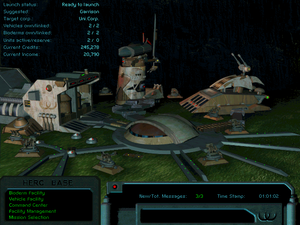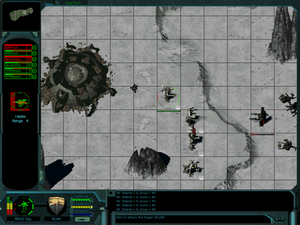
CyberStorm 2: Corporate Wars
Encyclopedia
CyberStorm 2: Corporate Wars is a turn-based strategy game developed by Dynamix
and released in 1998 as a sequel to MissionForce: CyberStorm
. It was published by Sierra Entertainment
.
A jumpgate
has been discovered in the Typheous system, and eight Earth corporations want to control it. Each of them therefore starts up a branch
in the system, and begin to battle it out with the latest in military technology.
, using many of the same graphical assets, although several changes to the gameplay has been made.
There are two modes of play: turn-based
and real-time
. The player begins by choosing which corporation they want to work for, each of which has their own strengths and weaknesses in different areas, such as finances, engineering and bioengineering as well as military capability.
The player progresses through a selection of random missions with special missions becoming available from time to time. These are written scenarios and tend to be quite profitable. The eventual goal is to take over the entire system by defeating all rival companies.
 There are other changes to the game mechanics as well: the player is now responsible for maintaining almost everything, from research allocation (needed to develop new weapons and other technologies), to base construction and defenses. Essentially, the player is in charge of a subsidiary
There are other changes to the game mechanics as well: the player is now responsible for maintaining almost everything, from research allocation (needed to develop new weapons and other technologies), to base construction and defenses. Essentially, the player is in charge of a subsidiary
of the parent corporation.
The player must secure all income for his/her base by setting up mines, either by finding unclaimed mining areas or destroying mining operations of rival corporations. Although the player can earn money on mission rewards, steady income only comes from the number of mines that the player can keep up.
Only steady income can be allocated to research. The player determines how fast the technology levels of weapons, armor, shielding, life support, sensors, etc. will progress by allocating funds to the various sections of research and the technology level of their command building in the base.
The player must also maintain the base. Options include improving the technology levels of the buildings, which make them harder to destroy and give them improved capabilities (command center controls research ability, vehicle bay technology level limits the types of units that can be built, launch pad limits the number of units that can be sent off world, turrets' technology level controls their firepower).
 The player may command only four to eight units on the battlefield at a time (the number depending upon which corporation they are aligned with). The player's units are dropped onto the battlefield to fight either rival corporations or the occasional Cybrid group. The player has many choices of units for their force, including:
The player may command only four to eight units on the battlefield at a time (the number depending upon which corporation they are aligned with). The player's units are dropped onto the battlefield to fight either rival corporations or the occasional Cybrid group. The player has many choices of units for their force, including:
Gameplay involves destroying buildings and/or enemy units. Buildings (including turrets) are unshielded, but can have very heavy and effective armor. Enemy units have shields and armor to defend them. Typically, the player must knock down one of the eight shield facings to create a hole using weapons that are effective against shields, then use weapons that are effective against armor to finish off the unit. Alternatively, some weapons can pass through shields, either partially or completely, to damage the armor underneath.
CyberStorm 2 mapping is based upon a grid system rather than the hexagonal one used in the first game. This gives the units eight directions of facing (four box sides, plus four corners), and shields are now octagonal in shape to work with the new map layout.
Dynamix
Dynamix, Inc. was an American developer of computer games from 1984 to 2001, best known for their flight simulator, Red Baron, the Front Page Sports series, Betrayal at Krondor, and their online multiplayer game, Tribes.-History:...
and released in 1998 as a sequel to MissionForce: CyberStorm
MissionForce: CyberStorm
MissionForce: CyberStorm is a turn-based strategy game developed by Dynamix and published in 1996 by Sierra Entertainment...
. It was published by Sierra Entertainment
Sierra Entertainment
Sierra Entertainment Inc. was an American video-game developer and publisher founded in 1979 as On-Line Systems by Ken and Roberta Williams...
.
Plot
CyberStorm 2 takes place long after the events of the first game, with the Cybrids no longer representing a major threat.A jumpgate
Jumpgate
In science fiction, a jump gate is a fictional device able to create a wormhole or portal, allowing fast travel between two points in space...
has been discovered in the Typheous system, and eight Earth corporations want to control it. Each of them therefore starts up a branch
Permanent establishment
A permanent establishment is a fixed place of business which generally gives rise to income or value added tax liability in a particular jurisdiction. The term is defined in many income tax treaties and most European Union Value Added Tax systems. The tax systems in some civil law countries...
in the system, and begin to battle it out with the latest in military technology.
Gameplay
The game is played from a top-down isometric view-perspective. In some respects it is quite similar to MissionForce: CyberStormMissionForce: CyberStorm
MissionForce: CyberStorm is a turn-based strategy game developed by Dynamix and published in 1996 by Sierra Entertainment...
, using many of the same graphical assets, although several changes to the gameplay has been made.
There are two modes of play: turn-based
Turn-based tactics
Turn-based tactics , or tactical turn-based , is a computer and video game genre of strategy video games that through stop-action simulates the considerations and circumstances of operational warfare and military tactics in generally small-scale confrontations as opposed to more strategic...
and real-time
Real-time strategy
Real-time strategy is a sub-genre of strategy video game which does not progress incrementally in turns. Brett Sperry is credited with coining the term to market Dune II....
. The player begins by choosing which corporation they want to work for, each of which has their own strengths and weaknesses in different areas, such as finances, engineering and bioengineering as well as military capability.
The player progresses through a selection of random missions with special missions becoming available from time to time. These are written scenarios and tend to be quite profitable. The eventual goal is to take over the entire system by defeating all rival companies.
Corporate Mechanics

Subsidiary
A subsidiary company, subsidiary, or daughter company is a company that is completely or partly owned and wholly controlled by another company that owns more than half of the subsidiary's stock. The subsidiary can be a company, corporation, or limited liability company. In some cases it is a...
of the parent corporation.
The player must secure all income for his/her base by setting up mines, either by finding unclaimed mining areas or destroying mining operations of rival corporations. Although the player can earn money on mission rewards, steady income only comes from the number of mines that the player can keep up.
Only steady income can be allocated to research. The player determines how fast the technology levels of weapons, armor, shielding, life support, sensors, etc. will progress by allocating funds to the various sections of research and the technology level of their command building in the base.
The player must also maintain the base. Options include improving the technology levels of the buildings, which make them harder to destroy and give them improved capabilities (command center controls research ability, vehicle bay technology level limits the types of units that can be built, launch pad limits the number of units that can be sent off world, turrets' technology level controls their firepower).
Combat

- "HERCs" (Humaniform-Emulation Roboticized Combat Unit with Leg-Articulated Navigation): these are the walking giant robots of the game. HERCs move somewhat slower than other units but are able to jump up and down terrain levels. HERCs always turn to face their target. Most of the HERCs from the first game are available, as well as several new models.
- Tanks: Ground based tanks have a turret which rotates and tracks the enemy. This is a substantial difference from the other units, since ground tanks need not turn their bodies to fire at their target. Shield focus still moves with the body, not the turret.
- Grav Tanks: Gravitiational drive tanks hover, are very fast, and are not limited by terrain. However, the armament, armor, and shielding of the grav tank tends to be far inferior to the ground tank or the herc. Grav tanks have no turret, and always turn to face their target.
Gameplay involves destroying buildings and/or enemy units. Buildings (including turrets) are unshielded, but can have very heavy and effective armor. Enemy units have shields and armor to defend them. Typically, the player must knock down one of the eight shield facings to create a hole using weapons that are effective against shields, then use weapons that are effective against armor to finish off the unit. Alternatively, some weapons can pass through shields, either partially or completely, to damage the armor underneath.
CyberStorm 2 mapping is based upon a grid system rather than the hexagonal one used in the first game. This gives the units eight directions of facing (four box sides, plus four corners), and shields are now octagonal in shape to work with the new map layout.
External links
- CyberStorm 2: Corporate Wars at GameFAQsGameFAQsGameFAQs is a website that hosts FAQs and walkthroughs for video games. It was created in November 1995 by Jeff "CJayC" Veasey and was bought by CNET Networks in May 2003. It is currently owned by CBS Interactive. The site has a database of video game information, cheat codes, reviews, game saves,...

